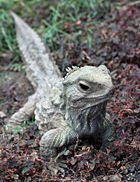Tuatara Are Back After 200 Years!
Posted by: Loren Coleman on October 31st, 2008
A male tuatara named Henry, living at the Southland Museum and Art Gallery, is still reproductively active at 111 years of age.
Well, the tuataras have been around for a time now, but scientists are excited because a breeding colony has been confirmed established.
The rare reptile with a lineage dating back to the dinosaur age has been found nesting on the New Zealand mainland for the first time in about 200 years, officials said Friday, October 31, 2008.
Four leathery, white eggs from an indigenous tuatara were found by staff at the Karori Wildlife Sanctuary in the capital, Wellington, New Zealand, during routine maintenance work Friday, conservation manager Rouen Epson said.
“The nest was uncovered by accident and is the first concrete proof we have that our tuatara are breeding,” Epson said. “It suggests that there may be other nests in the sanctuary we don’t know of.”
Tuatara, dragon-like reptiles that grow to up to 32 inches, are the last descendants of a species that walked the earth with the dinosaurs 225 million years ago, zoologists say.
They have unique characteristics, such as two rows of top teeth closing over one row at the bottom. They also have a pronounced parietal eye, a light-sensitive pineal gland on the top of the skull. This white patch of skin – called its “third eye” – slowly disappears as they mature.
A native species to New Zealand, tuatara were nearly extinct on the country’s three main islands by the late 1700s.
The tuatara (Sphenodon punctatus) has been classified as an endangered species since 1895 (the second species, Sphenodon guntheri, was not recognized until 1989). Tuatara, like many of New Zealand’s native animals, are threatened by habitat loss and the introduced Polynesian Rat (Rattus exulans). They were extinct on the mainland, with the remaining populations confined to 32 offshore islands, until the first mainland release into the heavily fenced and monitored Karori Wildlife Sanctuary in 2005.
A population of 70 tuatara was established at the Karori Sanctuary in 2005. Another 130 were released in the sanctuary in 2007.
The sanctuary, a 620-acre wilderness minutes from downtown Wellington, was established to breed native birds, insects and other creatures securely behind a predator-proof fence.
Empson said that the four eggs – the size of pingpong balls – were unearthed Friday but that there were likely more because the average nest contains around ten eggs.
The eggs were immediately covered up again to avoid disturbing incubation.
If all goes well, juvenile tuatara could hatch any time between now and March, she said.
These reptiles, on average, live to be about 60 years old, but they can reach 100 years of age.
Although tuatara are sometimes called “living fossils,” recent taxonomic and molecular work has shown that they have changed significantly since the Mesozoic era. Of course, it is not clear if they might experience each other as “living fossils” because they live so long.
Contributing: Ray Lilley, AP, other background herp sourcing.
About Loren Coleman
Loren Coleman is one of the world’s leading cryptozoologists, some say “the” leading living cryptozoologist. Certainly, he is acknowledged as the current living American researcher and writer who has most popularized cryptozoology in the late 20th and early 21st centuries.
Starting his fieldwork and investigations in 1960, after traveling and trekking extensively in pursuit of cryptozoological mysteries, Coleman began writing to share his experiences in 1969. An honorary member of Ivan T. Sanderson’s Society for the Investigation of the Unexplained in the 1970s, Coleman has been bestowed with similar honorary memberships of the North Idaho College Cryptozoology Club in 1983, and in subsequent years, that of the British Columbia Scientific Cryptozoology Club, CryptoSafari International, and other international organizations. He was also a Life Member and Benefactor of the International Society of Cryptozoology (now-defunct).
Loren Coleman’s daily blog, as a member of the Cryptomundo Team, served as an ongoing avenue of communication for the ever-growing body of cryptozoo news from 2005 through 2013. He returned as an infrequent contributor beginning Halloween week of 2015.
Coleman is the founder in 2003, and current director of the International Cryptozoology Museum in Portland, Maine.












Wow, this is a really cool article. Its really sad the punishment these unique animals, and indeed New Zealand animals in general, have taken from introduced species such as the Polynesian rat mentioned in the article.
111 years old! Awesome!